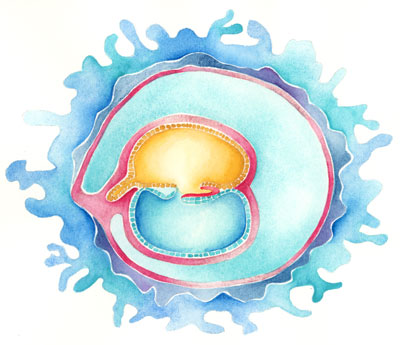It’s time to sound the drum roll. You’re 3 weeks pregnant. This is the week your baby is conceived! If you have been trying to conceive you will have earmarked the magic four days this week which will give you your best chance of success. You have made love on some (or maybe all!) of those days… so when is the magic moment? It’s tricky to pinpoint that exactly. Remember that sperm are microscopic. They have a long journey to make from your vagina all the way up through your uterus to your fallopian tube. Yes… that’s right… that’s where your baby will be created before making the journey all the way to your uterus this week.
 Your Baby when 3 Weeks Pregnant
Your Baby when 3 Weeks Pregnant
Your 3rd week of pregnancy and fertilisation has been successful. The genetic code within your egg has combined with the genetic code inside the one lucky sperm that entered it, creating your baby. The chromosomes within your ovum will create every part of your baby. The bone, muscle, skin, organs – as well as your baby’s placenta and umbilical cord. This is why our children resemble their biological mother and father. Half of their genes come from each of their biological parents respectively.
Within that genetic code is the code for gender. What determines a female baby is the presence of two X sex chromosomes (XX). A male baby is determined by the presence of an X and a Y sex chromosome. Because a woman only ever has an X chromosome to offer in her eggs, it is the sex chromosome within sperm that determines gender. Your eggs will only ever contain an X but sperm will contain either an X or Y sex chromosome. Combined with your X, an X sperm will create a female baby (XX) and a Y sperm will create a male baby (XY). That’s right. You are only three weeks pregnant and your baby’s gender is already a certainty.
While fertilisation is occurring, your ovum is being swept along your fallopian tube towards your uterus. This is where it will hopefully implant in your uterus. This journey takes around six to seven days and by the end of it your egg will contain a cluster of around 100 cells and be called a blastocyst.
Your Mind and Body
Assuming your baby is being conceived naturally, at 3 weeks pregnant despite all the activity occurring inside you, you will be unaware that you are pregnant. Once fertilisation occurs your body will start producing a hormone called Human Chorionic Gonadotrophin (HCG). This hormone in turn prompts your ovaries to keep producing progesterone which stops your uterus from shedding its lining – that is it stops your period from occurring. It is HCG that pregnancy tests are attempting to detect. HCG can first be detected in your blood around 11 days after conception. or In your urine between 12 and 14 days after conception.
Meanwhile, the progesterone being created by your ovaries will weave its own magic… some of it not quite delightful. Your ovaries are performing a stopgap exercise, producing the progesterone necessary to preserve your pregnancy (stop your periods) until the placenta can take over around seven weeks from now. It’s an incredibly important job! However, progesterone is also the hormone to blame for most of the unpleasant symptoms of early pregnancy. Examples are nausea, constipation, indigestion, and reflux… but at 3 weeks pregnant you are safe from those symptoms.
How Fertilisation Occurs
Your ovum is like a homing beacon to sperm. The 300 million or so sperm released by your partner make a beeline for your egg, swimming through your cervix, up through your uterus, and finally, into the fallopian tube, your egg is currently travelling down. Those sperm that make it that far will then attempt to break through the ovum’s outer shell. The first one to do so wins the chance for the genetic code it carries to be combined with that of your ovum and create your baby.
As soon as a sperm makes it through that outer shell a biochemical reaction occurs that hardens the shell of your ovum making it impenetrable to sperm. This reaction is what prevents more than one sperm from entering your ovum. So what happens next? In the case of a healthy ovum and sperm, the cells within the egg will begin dividing. A single cell becomes two, which becomes four, which becomes eight, and so on. During the journey down your fallopian tube, the cells will begin differentiating themselves into two distinct purposes. Those that will create your baby, and those that will create his or her placenta.
But what if your baby is conceived using artificial reproductive technology (ART)? The process of fertilisation itself is the same. The only difference is where and how it occurs. ART procedures are too complex to explain here. An article is included in the resource list below which explains them in some detail. Generally, ART involves the combination of sperm and an egg in a culture within a laboratory environment. The goal of the course is to create embryos that can then be transferred to the woman’s uterus. Generally, couples will be using their own egg and sperm respectfully but sometimes donor eggs or sperm may be used.
Your cycle will be tracked to determine the ideal time to transfer the embryo. This is in order to match and mimic the natural rhythms of your body. While the process used to create your embryo is a long way from natural fertilisation, once the transfer occurs the process of implantation occurs in exactly the same way. Your ovum and the sperm that fertilised it have simply skipped the race to conception and the ride down your fallopian tube.
Pregnancy Tests
If you are trying to conceive you will undoubtedly be eager to find out if this month you have hit the jackpot. The desire to find out can be so strong. Some women will start using urine pregnancy tests the day after they have sex, in the hopes of a nice surprise.
But at 3 weeks pregnant conception has only just occurred. The reality is that even the most sensitive pregnancy tests cannot detect pregnancy more than about five days before your period is due. The reason is a simple one. Until your HCG levels have risen sufficiently there is not enough of the hormone present in your urine to be detected by a pregnancy test.
Beyond the expense of buying and using pregnancy tests far earlier than they could reasonably be of any use, repeated early testing can create a great deal of anxiety. Early tests will invariably come up negative creating disappointment which might not even be warranted! To keep stress and anxiety to a minimum, try to resist the urge to use pregnancy tests this week. It is far better to get one reliable answer than several unreliable ones!
Worried or Concerned?
The information contained in this article is intended as a guide only. Please contact your midwife, obstetrician, or GP for an individual diagnosis and assistance. This is especially if you are experiencing any unsettling symptoms. Examples are pain or bleeding, or are concerned about any other aspect of your pregnancy.
Page updated last 8th March 2022



Recent Comments